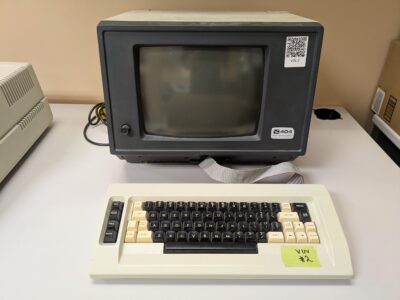Volker Craig VC404
The Volker Craig VC404 was a Canadian-made video display terminal introduced in 1978, notable for its affordable design, 12-inch anti-glare screen displaying 24 lines of 80 characters, and robust RS232C serial connectivity, making it accessible to students and institutions at a time when video terminals were prohibitively expensive. Its claim to fame lies in democratizing electronic information display—helping transition computing from paper-based workflows to screen-based interaction—and establishing Canada as an early innovator in computer terminal technology, with global sales and a significant partnership with Samsung. The VC404 was especially important in the history of computing for its role in making interactive computing more accessible and was widely adopted in Canada and internationally, cementing Volker-Craig’s reputation as a pioneer in the field.

- Manufacturer: Volker-Craig Ltd., a Canadian company founded in Waterloo, Ontario, by University of Waterloo graduates Michael C. Volker and Ronald G. Craig
- Type: Video display terminal
- Released: 1978
- Cost at release: $550 (~$2,600 adjusted for inflation)
- MIPS: N/A
Hardware Specifications
- Processor: No microprocessor; the VC404 used discrete TTL logic for its operation (not a microprocessor-based terminal)
- Memory: Screen memory (video RAM) sufficient for 80×24 character display; no general-purpose RAM or ROM as in microprocessor-based systems
- Storage: N/A
- Ports: Serial EIA RS232C interface, supporting data rates from 110 up to 19,200 baud
- Display: 12-inch anti-glare CRT, 80 characters x 24 lines, normal or reverse video, character highlighting
Operating System & Programming Languages
- None (Video display terminal)
Notables
- The Volker-Craig VC404 was one of the earliest affordable video display terminals, designed and manufactured in Canada by University of Waterloo graduates, and helped make interactive computing accessible to students and institutions worldwide.
- Its keyboard featured Datanetics key switches, the same type used in early Apple II computers, which is a rare and notable hardware detail.
- Volker-Craig exported the VC404 globally, and its success contributed to Waterloo’s reputation as a Canadian tech hub and the emergence of the “Canada’s Technology Triangle”.
- The VC404 had no microprocessor, using discrete logic instead, which was typical for terminals of its era but soon became obsolete as microprocessor-based models emerged.
- The company later became part of NABU Manufacturing in Ottawa, connecting the VC404’s legacy to the innovative NABU Network—an early precursor to online services in Canada.
- The VC404 and its successors were sometimes nicknamed “The Chat” (for the VC4404 model), and were known for supporting multiple character sets and CRT colors to appeal to international markets.
- Volker-Craig terminals were widely used in universities and exported to over 25 countries, making them a significant Canadian export in the early computer era
Donated By: Arlen Michaels
Carleton University: Used to connect to Carleton’s CP6 mainframe
Canadian: The Volker-Craig VC404 was designed and manufactured in Canada by University of Waterloo graduates. The company later became part of NABU Manufacturing in Ottawa.